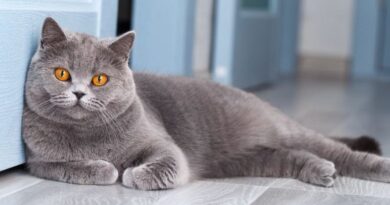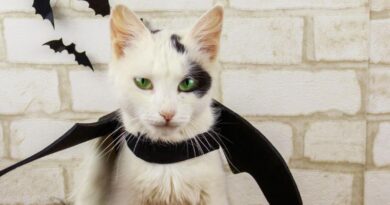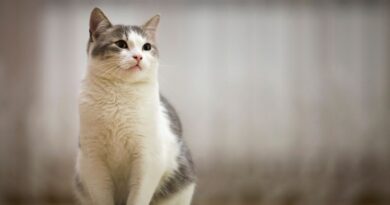Understanding your cat body language is like deciphering a secret code to their emotions and needs. Cats are subtle communicators, expressing themselves through various behaviors. When they arch their back and purr, it often signifies contentment and relaxation. A twitching tail might indicate excitement or agitation, while flattened ears signal fear or discomfort.
Observing their posture, from a relaxed loaf to an attentive stance, provides insight into their mood. By interpreting these signals, you can foster a deeper connection and ensure a harmonious relationship. Responding appropriately, such as giving space when they seem tense or offering affection when they’re relaxed, strengthens the bond between you and your feline companion. It’s a silent language that, when understood, enriches your interactions and creates a more fulfilling companionship.
Cat Body Language Signs
Tail Position
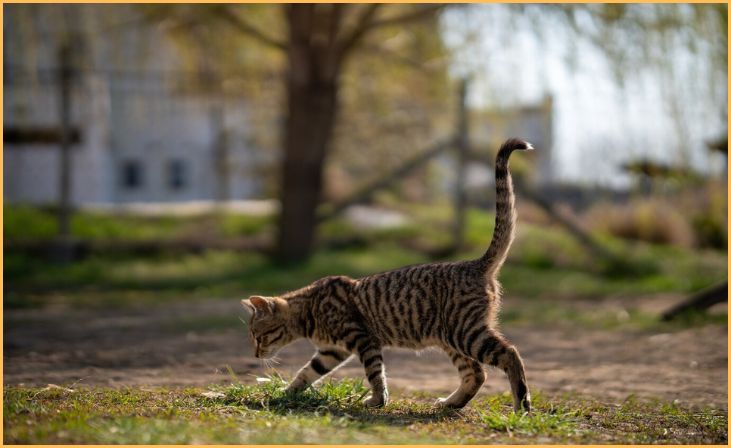
A cat’s tail acts as a nuanced communicator, conveying a spectrum of emotions through its positions. A raised tail, often with a slight curve at the tip, typically signifies a happy, confident cat, ready for interaction and expressing contentment. Conversely, a puffed-up tail, resembling a bottlebrush, is a clear sign of fear or aggression, indicating they feel threatened or stressed.
Observing your cat’s tail offers invaluable cues about their current emotional state. A gently swaying tail might denote curiosity, while a rapid back-and-forth motion could indicate irritation. Additionally, a tucked or low-hanging tail suggests discomfort or submission.
Read also: 7 Fascinating Hybrid Cat Breeds
Purring
Purring is commonly linked to contentment, but its meaning extends beyond happiness. Cats often purr when they’re relaxed and enjoying affection, but they might also purr when they’re in pain or distress. Understanding the context surrounding their purring is crucial. If accompanied by other signs of relaxation, like a relaxed body or kneading, it’s likely a sign of contentment.
However, if your cat purrs excessively or in situations where they seem uncomfortable—such as while eating or when touched in a specific area—it could signal pain or distress. By paying attention to these nuances, you can respond appropriately, providing comfort or seeking veterinary care when needed. It’s a reminder that while purring is often a joyful sound, its context holds the key to understanding your cat’s needs and emotions.
Ears Back
A cat’s ears are like emotional barometers, and when flattened against their head, they signal discomfort or anxiety. This position often accompanies feelings of irritation, fear, or stress. Observing your cat’s ear posture helps decode their emotions. If their ears are tightly pressed back, it’s crucial to adapt your approach. Your cat might need space or a calm environment to alleviate their distress.
Pairing this observation with other body language cues, such as a tense body or dilated pupils, provides a clearer understanding of their emotional state. By respecting their signals and adjusting your interactions accordingly—offering reassurance or giving them a peaceful environment—you can help your cat feel more comfortable and secure. It’s a non-verbal language that, when understood, strengthens the bond between you and your feline companion.
Kittenish Play
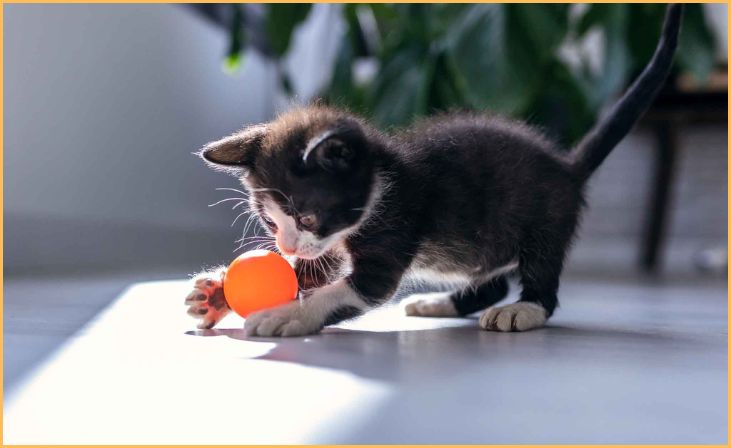
Playfulness in cats serves multiple purposes beyond entertainment. Engaging in playful activities like pouncing, chasing, and batting at objects isn’t just about fun—it’s a way for cats to bond with their environment and burn off excess energy. Recognizing these signs of playfulness is crucial in creating an environment that nurtures their natural instincts.
Providing toys and opportunities for interactive play not only entertains them but also fosters their physical and mental well-being. It’s a way for cats to express their predatory instincts in a safe and stimulating manner. By encouraging and participating in their play, you strengthen your bond with your feline companion and contribute to their overall happiness and health. Understanding and supporting their play behaviors is essential in ensuring a fulfilling and enriched life for your cat.
Belly Exposure
When a cat exposes its belly, it appears like an invitation, but it’s often a deceptive move. Despite its apparent openness, most cats are sensitive about their bellies. Touching or approaching this area might trigger a defensive reaction. Understanding this behavior is key to respecting your cat’s boundaries. Their belly display could stem from comfort or a relaxed state, but it doesn’t necessarily mean they want a belly rub.
It’s a vulnerable spot for them, and misinterpreting their gesture might lead to discomfort or even a defensive response, like gentle nibbling or clawing. Recognizing this subtle communication helps maintain trust and prevents misunderstandings. Respecting their boundaries reinforces the bond between you and your cat, ensuring a positive and respectful relationship built on understanding and mutual trust.
Scratching
Scratching is an instinctual behavior for cats, serving both territorial marking and claw maintenance purposes. Understanding this natural inclination is crucial in preserving your furniture and supporting your cat’s well-being. By providing a designated scratching post, you offer an outlet for this innate behavior, redirecting their attention away from your furnishings.
Opt for posts that match your cat’s preferences in material and height, encouraging them to use it regularly. Regular use not only helps maintain their claws but also aids in stretching their muscles. Moreover, placing the scratching post strategically near areas they frequent reinforces its appeal. By accommodating this need, you create a win-win situation—preserving your furniture while allowing your cat to engage in a necessary and instinctive behavior.
Read also: 10 Cat Breeds With Black and White Coloring
Hissing and Growling
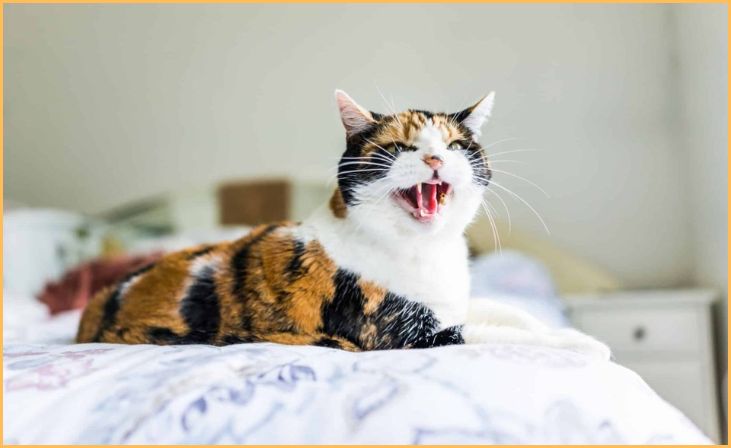
Vocalizations like hissing and growling serve as unmistakable signals of aggression or extreme fear in cats. When your cat exhibits these sounds, it’s a critical moment to recognize their distress. Reacting by giving them space and refraining from actions that could heighten their anxiety is crucial. Avoid direct eye contact, sudden movements, or attempting to comfort them physically, as these actions might escalate their fear or aggression. Instead, create a calm environment and allow your cat to retreat to a safe space.
Providing distance and time for them to calm down is essential. Respecting their signals during these moments helps prevent further stress, allowing your cat to regain a sense of security and reducing the likelihood of a confrontation. Understanding and responding appropriately to their vocal cues can defuse tense situations and maintain a trusting relationship.
Conclusion
Understanding cat body language is akin to unlocking a secret code to their emotions and needs. Their tail, posture, and gestures form a visual language that speaks volumes about their state of mind. By keenly observing these cues, we can respond appropriately, fostering a deeper bond and ensuring a harmonious relationship. This silent communication enriches our interactions, allowing us to create a more fulfilling companionship with our feline friends.
FAQs
Cats display stress through various cues like flattened ears, dilated pupils, excessive grooming, or hiding. A twitching or low-hanging tail can also indicate anxiety.
Kneading, where a cat rhythmically presses their paws, often signifies comfort and contentment. It’s a behavior reminiscent of kittenhood and can indicate relaxation.
Rapid tail flicking is a sign of irritation or agitation in cats. It’s crucial to identify the cause—whether it’s discomfort, annoyance, or overstimulation—and give your cat space if needed.
Flattened ears indicate fear, anxiety, or aggression in cats. It’s a defensive posture, suggesting they feel threatened or stressed.
Playful behavior often includes a relaxed body, ears forward, and a gently swaying tail. Aggression, on the other hand, may involve hissing, growling, a puffed-up tail, and a tense body posture. Understanding the context and accompanying cues helps differentiate between the two.


